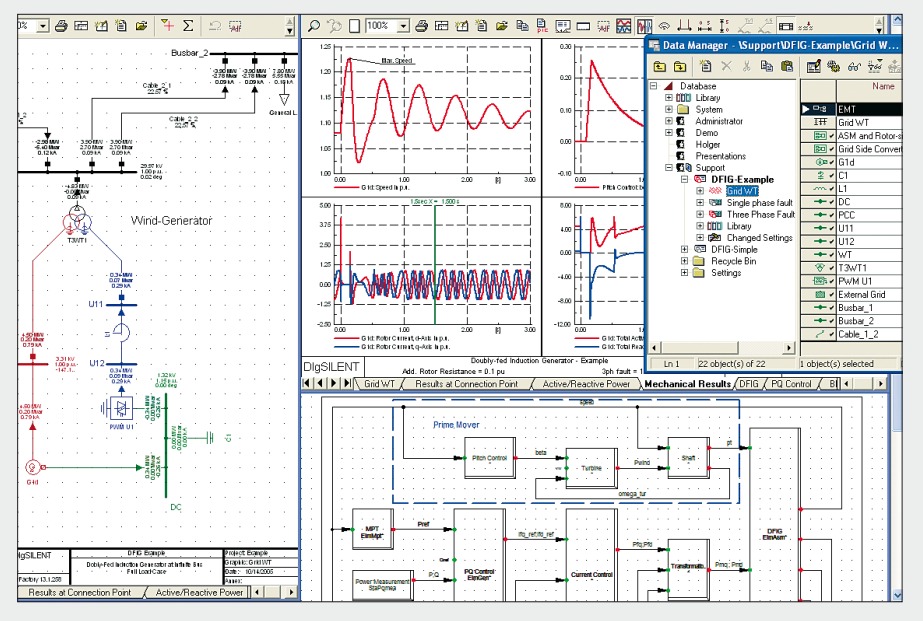Grid Compliance Analysis
SEN ELECTRICAL DESIGN SYSTEM Power Consulting is an Electrical Engineering Consultancy, that specialises in Power Systems Analysis and modelling. We undertake a wide range of studies, using the latest software and techniques to carry out analysis for large and complex power systems. Typical activities include G99 / Grid Code Compliance/ECC, Harmonic Studies, Protection Coordination, Arc Flash, System Stability, Voltage Fluctuations, Load Flow, Short Circuit and Transient Analysis. SEN EDS has a team of highly experienced engineers, who have worked on projects all around the globe, ranging from simple low voltage systems up to complex 400kV grid transmission systems, to ensure that whatever your problem, we can help you solve it! We work with a wide range of National and International Clients, and across a diverse range of industries including Renewable Power, Solar and Wind with BESS. At SEN EDS we have a simple but effective philosophy: “At SEN EDS we believe that the best way to grow our business, is by helping you, grow your business.”

A. Load Flow Study
Load Flow Analysis, also known as Power Flow Analysis, is a foundational study that models and analyzes the steady-state behavior of an electrical grid. It determines how power flows through the grid under different operating conditions, including load levels, generation, and equipment statuses.
Load Flow Analysis ensures that the facility’s power generation or energy storage does not exceed the grid’s capacity and that voltage levels are within acceptable limits. It provides essential information about active power (real power) and reactive power (volt-amperes) flows, helping to identify potential issues such as voltage violations and line overloads.
B. Short Circuit Analysis
Short Circuit Analysis evaluates the behavior of the electrical grid during fault conditions, such as short circuits or faults on the grid. This analysis determines the magnitude of fault currents, fault locations, and the time it takes for protective devices (circuit breakers, relays) to operate and clear faults.
Short Circuit Analysis ensures that the facility can safely withstand and respond to fault currents without causing equipment damage or compromising grid stability. It also helps in coordination with protective devices to ensure that the facility disconnects during fault conditions as required by grid codes.
C. Power Quality Study
Evaluate the impact of the facility on power quality, considering harmonics, flicker, and voltage regulation.
D. Protection Coordination Study
Ensure proper coordination between the facility’s protection systems and the grid’s protection systems to disconnect during grid faults.
E. Reactive Power Capability Assessment
Grid codes often require renewable energy facilities to provide or absorb reactive power to support grid voltage control. This study assesses the facility’s ability to meet these reactive power requirements.
F. Frequency Response Analysis (FSM & LFSM)
Assess the facility’s response to grid frequency deviations and its ability to assist in grid frequency regulation.
G. Low Voltage Ride-Through (LVRT) Study
Evaluate the facility’s ability to remain connected during short-duration voltage dips or sags.
H. High Voltage Ride-Through (HVRT) Study
Analyze the facility’s ability to withstand and remain connected during over-voltage events, ensuring grid stability during such conditions.
I. Earthing Study
- Ensure proper grounding and earthing systems are in place to maintain electrical safety and prevent over-voltage and fault risks.
- Through sophisticated numerical modelling and simulations, earthing analysis examines various aspects, including fault current dissipation, step and touch voltage levels, electromagnetic field distributions, and soil resistivity characteristics. The analysis aims to confirm that the grounding system can effectively and safely carry fault currents to the ground, preventing electrical shock hazards and minimizing the risk of equipment damage during fault conditions.
- Additionally, it evaluates the potential impact of the grounding system on surrounding structures and ensures compliance with safety standards and regulations. Earthing analysis plays a vital role in safeguarding both personnel and equipment, making it an essential component of electrical system design and maintenance.
J. Dynamic Modeling and Simulation
Develop dynamic models of the facility to simulate behavior under various grid conditions, including transient events.
K. Harmonics Analysis
Assess and mitigate harmonic distortion introduced by the facility into the grid to prevent power quality issues.
L. Flicker Analysis(P28)
Study and mitigate voltage flicker caused by the facility’s operation, ensuring it does not disrupt other connected equipment.
M. Fault Ride-Through (FRT) Study
Analyze the facility’s response to grid faults, confirming that it remains connected during certain fault conditions to support grid stability.
N. Voltage Control Study
The voltage control can be realized in general by the use of on-load tap changing transformers together with active and reactive power management provided by inverter-based distributed energy resources (DERs).
O. Lightning Fault Analysis (LFA)
Evaluate the facility’s susceptibility to lightning strikes and implement protection measures to minimize lightning-induced damage.
P. Transient Recovery Voltage (TRV) Study
Study the recovery voltage characteristics after a circuit breaker operation and ensure they comply with grid code requirements to avoid equipment damage.

